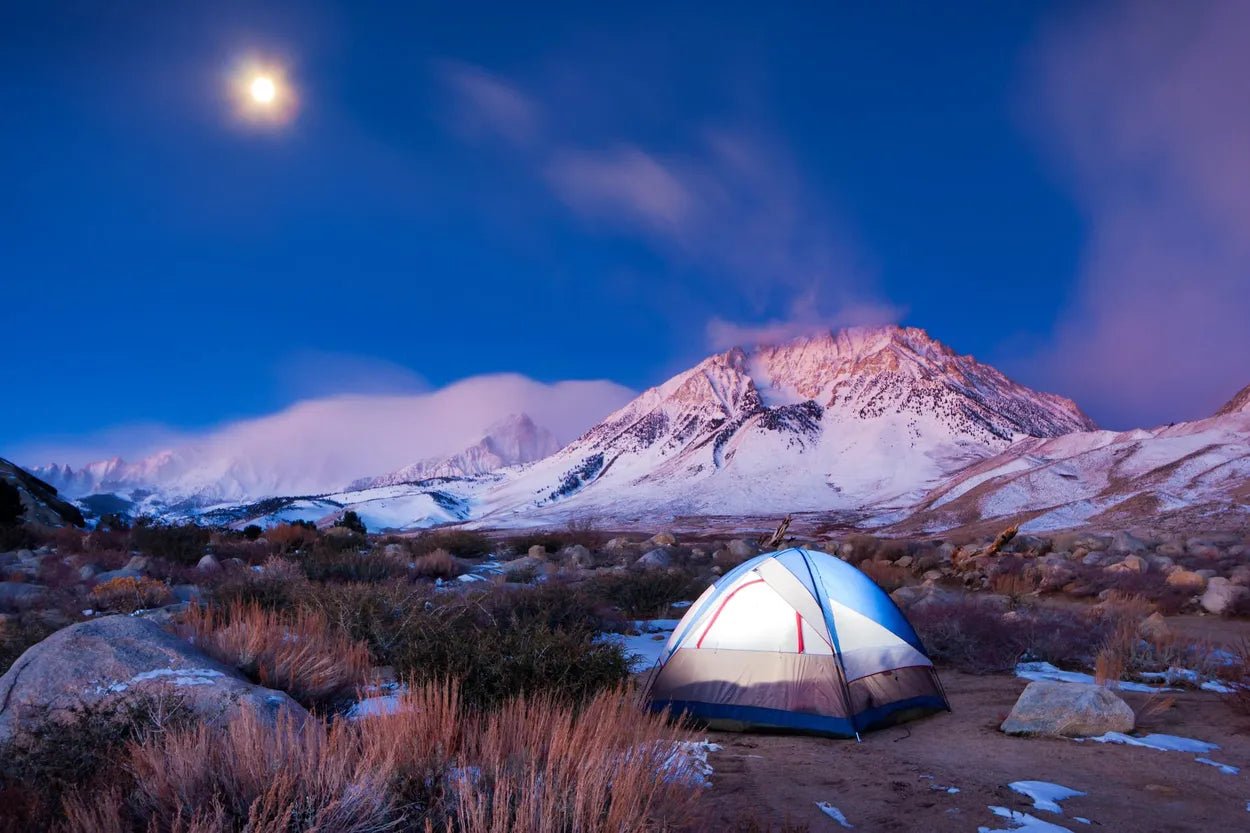There's a special tranquility found amidst a winter forest, with its gentle rustling of pine trees and an enchanting sky glittering with stars. But even such breathtaking scenes can't compensate for a cold, uncomfortable night during your cold weather camping adventure.
Whether you're navigating snowy paths with your skis or embarking on a snowshoe hike, having the right knowledge and gear to stay warm in a tent is crucial. This is especially true when temperatures venture below zero, making it vital to know how to sleep comfortably in such cold weather camping conditions.
That's where we come in. Our guide offers the best tips for camping in the cold, making sure your winter escapades are more about the thrill of the outdoors and less about battling the cold. Our curated advice will teach you how to stay warm while camping, ensuring your experience is enjoyable and comfortable. So, let's jump right in. Here are our 10 top strategies to ace camping in cold weather.

1. Check the Weather Conditions Before You Go
Outsmarting the elements starts with being informed. Whether you're braving desert cold snaps or weathering a snowstorm, your first line of defense is knowledge. Staying updated on weather systems, regional climate trends, and seasonal changes is crucial for your cold-weather camping adventure.
But don't stop there. Keep an eye out for recent changes in terrain, any trail closures, or potential hazards that may affect your trip. A call to the local ranger station can provide valuable insights into current conditions and keep you in the loop.
Before you set off, devise a solid trip plan and share it with reliable contacts. Let them know where you're going and when you're expected back. Remember, winter camping isn't just about bracing the cold—it's about strategic planning and clear communication.

2. Eat and Drink More
Camping in cold weather demands your body to burn more calories for heat. Maintain your inner fire stoked with continual snacking. Opt for meals rich in fat and protein at night; they metabolize slower than carb-heavy alternatives, providing sustained warmth and energy as you sleep under the stars.
Don't underestimate hydration, either—it's a pivotal factor in your body's ability to fight the cold. Avoiding dehydration eases your warming efforts and curbs fatigue. It's a good practice to gulp down enough water and yes, even venture out into the cold for nature's call during the night. Why? Your body expends valuable energy to heat the fluids in your bladder—energy that could be used to keep you warm.
For the adventurous, consider transforming an old wide-mouth water bottle into a dedicated nighttime 'pee bottle.' While the concept may be off-putting for some, the tightly sealed, warm bottle can serve as an additional heat source in your sleeping bag during emergencies.

3. Tech Gears for Warm Hands and Feet
When you're facing off against winter's chill in the wild, a little tech can go a long way. Consider compact solutions like hand warmers, heated gloves, and heated boots. They're not just about warding off the cold, but also keeping your hands and feet ready for action, no matter what tasks await.
Comfort isn't just a luxury; it's energy in the bank, ready to fuel your winter adventures. Imagine setting up camp with toasty hands in heated gloves, or taking a snowy hike with warm toes snuggled in heated boots.
And let's not forget about hand warmers. These little pocket pals are game-changers, delivering an instant hit of warmth when the mercury plummets. So, as you gear up for your cold-weather camping trip, don't skimp on these tech goodies.

4. Flip Things Upside Down
Prepping for freezing temperatures involves a little cunning. Consider the common scenario: it's the crack of dawn, you're in a winter wonderland, and everything's frozen solid—including your stove fuel and water. The solution? Turn things upside down.
As ice forms from the top down, flipping your containers ensures the openings stay ice-free, giving you access to your vital resources when you need them most. This trick can make the difference between a hot breakfast and a cold start to the day.
And don't just stop at water and fuel. Insulate and flip anything susceptible to freezing—your morning routine will thank you. So, before you turn in for the night, take a minute to flip things over. This simple upside-down hack is a clever way to outsmart Mother Nature, ensuring you stay one step ahead of the cold while camping.

5. Ensuring Flatness for Your Comfort and Safety
When embarking on a winter camping journey, your campsite selection and preparation are paramount. Begin by pinpointing a flat, dry, and sheltered spot. Clear away snow to expose the ground and using your camping gear, flatten the area, creating a perfect base for your tent.
Next, mold your personal sleeping pad within the tent. By applying pressure with your knees, you can smooth out the floor—preferably before any snow melt refreezes, which can complicate the task. And don’t forget to consider carving a shallow trough in your sleeping area for added comfort. It’ll help prevent you from rolling around while you rest. These steps not only ensure a snug and comfortable sleep, but are key in conserving heat and preventing potential cold-weather hazards like hypothermia.

6. Place Two Sleeping Pads Together
When it comes to winter camping, insulation is your best defense against the biting cold. Here's a secret from the pros—double up your sleeping pads for an extra layer of warmth. The benefit is twofold; not only do you gain additional comfort, but you also significantly improve insulation between you and the frosty ground.
And let's talk about R-values, a measure of thermal resistance. The magic here is simple; the R-values of two pads combine, giving you a warmer sleep surface.
An ideal pairing that I would suggest is a winter-grade air sleeping pad, equipped with reflective fabric, atop a closed-cell foam pad. This duo presents a formidable barrier against the cold in a lightweight, easy-to-pack format. Doubling up your sleeping pads could mean the difference between a frigid night under the stars and a restful sleep nestled in your cozy tent.

7. Avoid Camping Under Large Trees
When selecting a campsite, safety is as crucial as the view. An important tip to remember: steer clear of camping underneath large trees. It might seem like an idyllic spot, offering shelter and a dose of nature. However, in wet and stormy weather, these towering giants can pose a risk.
A rain-soaked branch could snap without warning, potentially causing harm or damaging your equipment. Nature's unpredictability warrants an extra layer of caution.
Instead, scout for the most open spot you can find. Opt for a location that provides a balance between exposure to the elements and safety from possible hazards. Cold-weather camping requires strategy, and where you set up camp can make a significant difference in your experience. Your winter camping adventure should be memorable for the beauty of the frost-tipped scenery—not an unwelcome surprise from above. Stay safe, and camp smart.

8. Protect Your Limbs
As we venture into the domain of cold-weather camping, special care must be taken to protect our extremities - it's an essential element to ensure a comfortable and enjoyable winter wilderness experience. Sure, the old adage about losing half of our body heat through our head has been debunked, but let's not underestimate the cozy comfort of a warm beanie. Especially for those of us who tend to keep our heads exposed while sleeping, a hat provides that much-needed shield against the chilly night air.
Additionally, don't overlook the importance of caring for your feet. Have a designated pair of socks for sleeping - your feet will thank you. By switching to dry, comfy socks at the end of the day, you help keep the cold at bay, ensuring your toes stay warm and cozy all night long.
In extremely cold temperatures, even your hands may need some extra love. Consider bringing along a pair of gloves for sleeping. They might seem overkill at first, but as the mercury drops, you'll appreciate the added warmth.
Above all, this isn't just about enhancing comfort; it's also a preventive measure against the frostbite that can sneak up in severe cold. So, as you prep for your winter camping adventure, give priority to safeguarding your extremities.

9. Never Tuck Your Head Inside Your Sleeping Bag
Resist the temptation to completely submerge yourself in the warm cocoon of your sleeping bag, keeping your face tucked away from the chill. It's natural to want to burrow down into your bag as temperatures drop, but doing so can create an unexpected issue – condensation.
Breathing inside your sleeping bag can lead to dampness, reducing its insulation properties, and leaving you feeling colder instead of warmer. The moisture from your breath can saturate the interior of your bag, lessening its ability to keep you toasty. This is similar to the dew that collects on the inside of your tent come morning.
So, when you're tucked in for the night, keep your mouth and nose exposed. It may seem counterintuitive, but this simple trick ensures your breath dissipates into the open air, not into your sleeping bag, preserving its thermal efficiency.

10. Use Lithium Batteries
Embrace the cold-weather superiority of lithium batteries on your winter camping adventure. Unlike their alkaline or NiMh counterparts, lithium batteries maintain consistent performance even in freezing conditions, and continue operating at temperatures where others would falter.
Additionally, they offer a superior lifespan and come in a lighter package, making them an optimal choice for winter camping gear. After all, every ounce matters when you're packing for the great outdoors.
Lithium batteries have become increasingly commonplace, so sourcing them should be a breeze. Remember, reliable power sources are a critical part of your winter camping setup, powering everything from flashlights to camping stoves. Opting for lithium batteries can mean the difference between being left in the dark or comfortably enjoying your winter camping experience.
Heading out for a winter camping trip can be a lot of fun, especially if you love the beauty of snowy landscapes. But, to have a good time, you need to be ready for the cold. We hope our tips have given you some great ideas to make your trip warm and cozy.
Being prepared is not just about having the right stuff. It's also about understanding how to handle the cold weather. Each tip we shared—from keeping an eye on the weather to using lithium batteries—is important for a safe and enjoyable winter camping trip.
Now that you've got these tips, it's time to get your winter gear, set up your tent in the snow, and have a great time winter camping. Safe travels and have fun in the snow!

